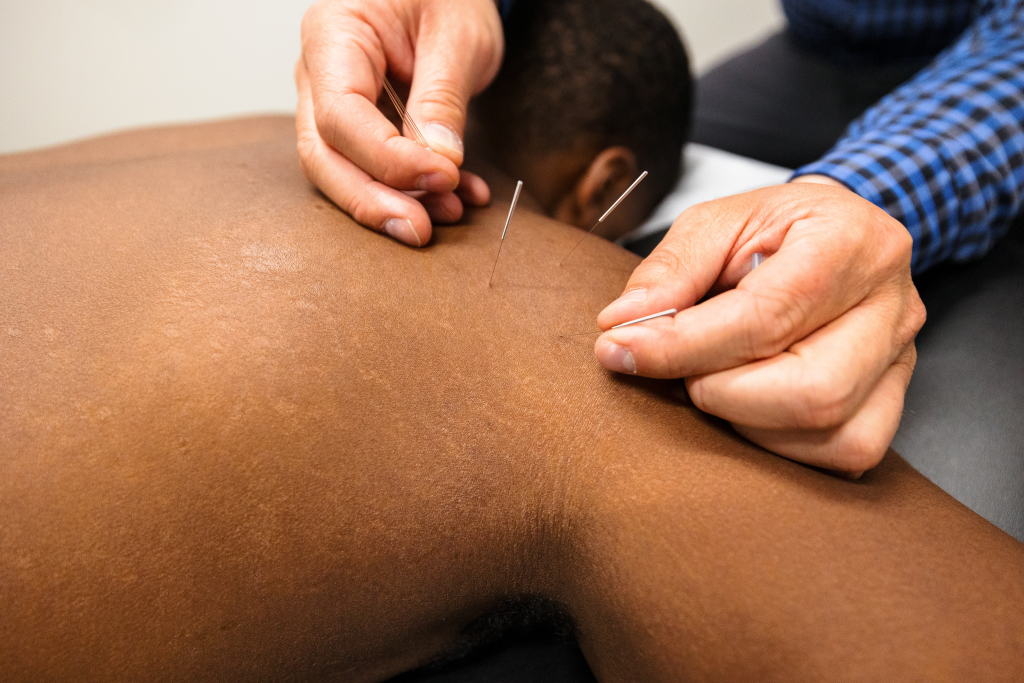In this blog post about Dry Needling for Shoulder Knots in Westerville and Columbus, we will dive into every aspect of what causes those stubborn knots in your upper traps, why they’re so common in people with desk jobs, poor posture, or chronic stress, and how dry needling offers fast, effective relief. We’ll explore the science behind dry needling, how it differs from other therapies like massage or acupuncture, what to expect during treatment, and why more people in Central Ohio are turning to this powerful technique to restore comfort and mobility.
If you’ve ever felt like you have a “knot” in your shoulder that just won’t go away, you’re not alone. Many people in Columbus and Westerville, Ohio visit our clinic complaining of persistent tension and pain in their upper trapezius muscles. These tight bands of muscle, commonly referred to as “knots,” can limit your range of motion, contribute to tension headaches, and affect your posture and daily function.
One of the most effective treatments for these muscle knots is dry needling—a technique increasingly used by chiropractors, physical therapists, and rehab specialists to relieve pain and restore normal muscle function. In this article, we’ll dive into the science behind muscle knots, how dry needling works, and why it might be the solution you’ve been looking for if you’re struggling with shoulder tension in the Columbus or Westerville area.
What Are Muscle Knots in the Shoulder?
Muscle knots, also known as myofascial trigger points, are hyperirritable spots within a taut band of skeletal muscle. In the upper trapezius region (the area spanning from the base of the skull to the shoulder), these knots often develop from:
- Poor posture, especially forward head position and rounded shoulders
- Prolonged sitting or desk work
- Stress-related muscle tension
- Repetitive strain or overuse
- Previous injuries
Trigger points can cause referred pain, meaning pain may radiate to nearby areas like the neck, jaw, or head. In fact, trigger points in the traps are a common contributor to tension-type headaches.
Why the Trapezius Muscle?
The trapezius muscle plays a crucial role in stabilizing and moving the shoulder blade and neck. Because of its size, function, and involvement in everyday movement (and stress!), it’s highly susceptible to chronic tension and the development of trigger points.
Clinically, we often see patients from Columbus and Westerville who have tried massage, stretching, and even medication with limited relief. This is where dry needling comes into play.
What Is Dry Needling?
Dry needling is a skilled intervention performed by trained healthcare providers where a thin monofilament needle is inserted directly into the myofascial trigger point. The goal is to create a localized twitch response, which leads to:
- Decreased muscle tightness
- Improved blood flow
- Normalized muscle electrical activity
- Reduction in pain signaling
Unlike acupuncture, which is based on traditional Chinese medicine and meridians, dry needling is rooted in modern neurophysiology and musculoskeletal science.

How Does Dry Needling Help Shoulder Knots?
When applied to the upper trapezius, dry needling can provide rapid relief for chronic shoulder tightness. Here’s how:
- Interrupts the Pain-Spasm Cycle
Trigger points create a vicious cycle of pain and muscle guarding. Dry needling disrupts this cycle by eliciting a twitch response and relaxing the tight muscle fiber. - Improves Local Circulation
Needling increases blood flow to the area, flushing out inflammatory chemicals and bringing in oxygen and nutrients for healing. - Reduces Referred Pain
By targeting the trigger point directly, dry needling can reduce associated symptoms like headaches, neck stiffness, and radiating shoulder discomfort. - Restores Range of Motion and Function
With muscle tension reduced, patients often see improvements in posture, strength, and daily movement patterns.
What to Expect During a Dry Needling Session
At Central Ohio Spine and Joint, conveniently located near Westerville and Columbus, our providers begin with a thorough examination to identify active trigger points and rule out other causes of shoulder pain.
During the session:
- You’ll lie comfortably while the provider palpates the affected muscle.
- A sterile, single-use needle is inserted into the trigger point.
- You may feel a quick muscle twitch or ache—this is normal and therapeutic.
- Mild soreness may occur afterward, similar to a post-workout muscle burn.
Most patients experience relief within 24-48 hours, and dry needling is often combined with corrective exercise, posture retraining, and manual therapy for the best long-term outcomes.
Is Dry Needling Safe?
Yes. When performed by trained professionals, dry needling is a safe and effective treatment. All procedures are done using sterile techniques and precise anatomical knowledge. Common side effects include mild soreness or bruising, but serious complications are rare.
Real Results in Columbus and Westerville
We’ve helped hundreds of patients in the Columbus metro and Westerville area find relief from persistent shoulder knots using dry needling. Whether you’re a desk worker with chronic trap tension, an athlete recovering from overuse, or someone dealing with postural stress, dry needling offers a research-backed, non-invasive treatment option.
Supporting Research
- Shah JP, et al. (2008). “Biochemicals associated with pain and inflammation are elevated in sites near active myofascial trigger points.” Archives of Physical Medicine and Rehabilitation.
- Dommerholt J, et al. (2006). “Trigger point dry needling.” Journal of Manual & Manipulative Therapy.
- Cagnie B, et al. (2013). “Effect of dry needling of the trapezius muscle on pain in office workers with myofascial trigger points.” Journal of Manipulative and Physiological Therapeutics.
Ready to Feel Relief?
If you’re tired of living with nagging shoulder knots and want a science-based, effective solution in Westerville or Columbus, our team at Central Ohio Spine and Joint is here to help. Schedule your evaluation today to see if dry needling is right for you.

Recent Comments